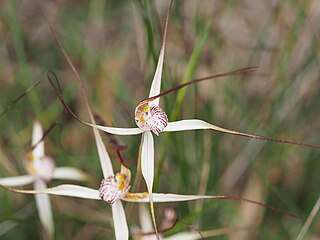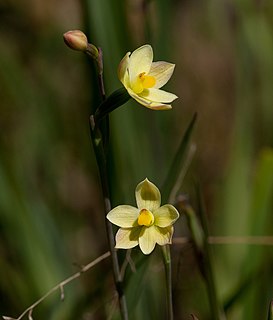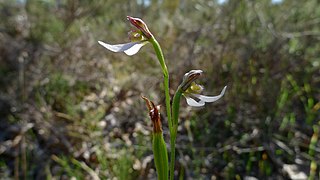
Caladenia paludosa, commonly known as the swamp spider orchid, is a species of orchid endemic to the south-west of Western Australia. It has a single erect, hairy leaf and up to three red, greenish-yellow and cream-coloured flowers. It mostly grows in dense scrub and is one of the last of the similar spider orchids to flower.
Caladenia erythronema, commonly known as the red thread spider orchid, and Nyabing spider orchid is a plant in the orchid family Orchidaceae and is endemic to the south-west of Western Australia. It has a single hairy leaf and up to three red, yellow or cream-coloured flowers with dangling, thread-like sepals and petals and a small labellum.

Caladenia excelsa, commonly known as the giant spider orchid, is a species of orchid endemic to a small area in the south-west of Western Australia. It is a rare species with a single, hairy leaf and up to three cream-coloured to greenish-cream flowers with long, drooping sepals and petals. It is one of the tallest spider orchids in Western Australia and, with Caladenia splendens, has the largest flowers of any Western Australian orchid.

Caladenia exilis subsp. exilis, commonly known as the salt lake spider orchid, is a plant in the orchid family Orchidaceae and is endemic to the south-west of Western Australia. It is a relatively common spider orchid with a single erect, hairy leaf and up to three white to greenish-cream flowers with a small white, red-striped labellum.

Caladenia horistes, commonly known as the cream spider orchid is a species of orchid endemic to the south-west of Western Australia. It has a single, hairy leaf and one or two, creamy-yellow flowers which have a red-striped labellum and long, dark, thread-like tips on the sepals and petals.
Caladenia melanema, commonly known as the ballerina orchid, is a species of orchid endemic to the south-west of Western Australia. It is a rare orchid with a single erect, hairy leaf and one or two cream-coloured to pale yellow flowers with red markings and black tips on the sepals and petals.
Caladenia meridionalis, commonly known as the south coast spider orchid, is a species of orchid endemic to the south-west of Western Australia. It is an early-flowering orchid with a single erect, hairy leaf and one or two white flowers with long, drooping lateral sepals and petals.

Caladenia multiclavia, commonly known as the lazy spider orchid is a species of orchid, endemic to the south-west of Western Australia. It has a single, hairy leaf and one or two greenish-yellow, red and cream-coloured flowers resembling a reclining spider. Although it usually only has a single flower, it often grows in clumps of up to six plants.
Caladenia nobilis, commonly known as the noble spider orchid, is a species of orchid endemic to the south-west of Western Australia. It has a single hairy leaf and one or two large white flowers with a red-marked labellum.
Caladenia pholcoidea subsp. pholcoidea, commonly known as the Albany spider orchid, is a plant in the orchid family Orchidaceae and is endemic to the south-west of Western Australia. It has a single hairy leaf and up to four pale yellow flowers with long drooping petals and lateral sepals.

Caladenia polychroma, commonly known as the Joseph's spider orchid, is a species of orchid endemic to the south-west of Western Australia. It has a single erect, hairy leaf and one or two relatively large and colourful but smelly flowers.

Caladenia radialis, commonly known as the drooping spider orchid, is a species of orchid endemic to the south-west of Western Australia. It has a single erect, hairy leaf and one or two red and cream-coloured flowers. In good seasons it forms clumps of up to ten plants.
Caladenia petrensis, commonly known as the rock spider orchid is a plant in the orchid family Orchidaceae and is endemic to the south-west of Western Australia. It has a single erect, hairy leaf and up to three pale yellow flowers with drooping lateral sepals and petals.
Caladenia validinervia, commonly known as the Lake Muir spider orchid, is a species of orchid endemic to the south-west of Western Australia. It has a single erect, hairy leaf and up to three greenish to creamy white flowers with red stripes on the sepals and petals. The flowers have relatively narrow sepals and petals and a relatively small labellum. It is a rare orchid only known from an area between Rocky Gully and Collie.

Thelymitra flexuosa, known as the twisted sun orchid, is a species of orchid that is endemic to southern Australia. It has a single thin, wiry leaf and up to four cream-coloured to canary yellow flowers with four rows of short hairs on the back of the column. It is a common and widespread species, superficially similar to T. antennifera.

Thelymitra benthamiana, commonly called the leopard sun orchid or blotched sun orchid, is a species of orchid in the family Orchidaceae and is endemic to Australia. It has a single leathery leaf and up to ten yellowish green flowers with brownish spots, blotches and patterns. The column is yellow with deeply fringed wings and the lobe on top of the anther has a large lump on its top.
Thelymitra fuscolutea, commonly called the chestnut sun orchid, is a species of orchid in the family Orchidaceae and is endemic to the south-west of Western Australia. It has a single erect, flat, leathery leaf and up to fifteen or more yellowish green flowers with reddish brown streaks and blotches. The column has broad, deeply fringed cream or whitish wings.
Thelymitra pulcherrima, commonly called the northern Queen of Sheba, is a species of orchid in the family Orchidaceae and endemic to the south-west of Western Australia. It has a single erect, spiral, dark green leaf with a purplish base and up to seven glossy, variegated flowers with the sepals and petals differing in colour. The petals and sepals and basically reddish or purplish but with streaks and blotches of contrasting colours. There are two bright yellow or orange arms on the sides of the column.
Calochilus uliginosus, commonly known as the swamp beard orchid, is a species of orchid endemic to Western Australia. It has a single dark green leaf with a reddish purple base and up to seven greenish to brownish flowers with red lines and a labellum with a reddish purple beard.

Eriochilus dilatatus, commonly known as the white bunny orchid, is a plant in the orchid family Orchidaceae and is endemic to Western Australia. It is a common and widespread, slender ground orchid with a single leaf and up to fifteen small white and greenish flowers with reddish or brownish markings and a hairy labellum.










